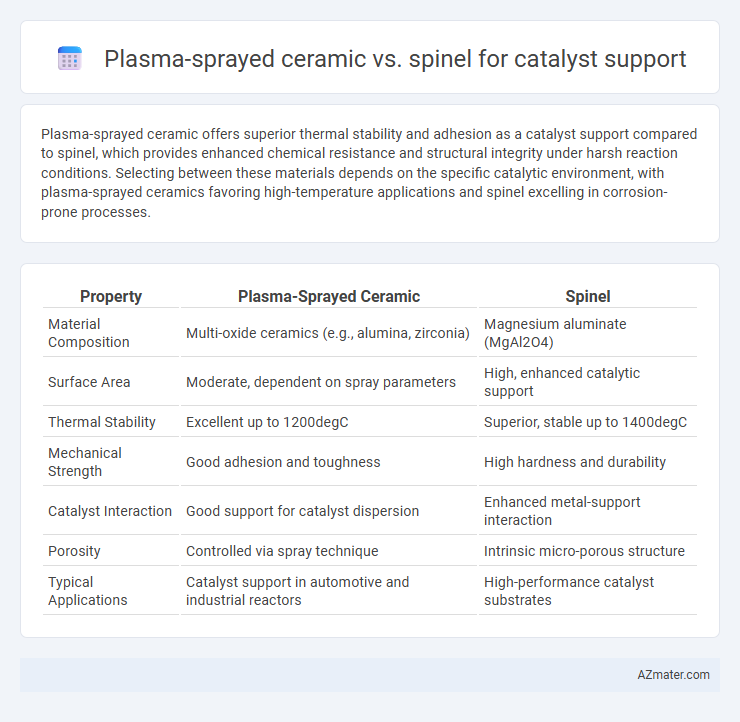Plasma-sprayed ceramic offers superior thermal stability and adhesion as a catalyst support compared to spinel, which provides enhanced chemical resistance and structural integrity under harsh reaction conditions. Selecting between these materials depends on the specific catalytic environment, with plasma-sprayed ceramics favoring high-temperature applications and spinel excelling in corrosion-prone processes.
Table of Comparison
| Property | Plasma-Sprayed Ceramic | Spinel |
|---|---|---|
| Material Composition | Multi-oxide ceramics (e.g., alumina, zirconia) | Magnesium aluminate (MgAl2O4) |
| Surface Area | Moderate, dependent on spray parameters | High, enhanced catalytic support |
| Thermal Stability | Excellent up to 1200degC | Superior, stable up to 1400degC |
| Mechanical Strength | Good adhesion and toughness | High hardness and durability |
| Catalyst Interaction | Good support for catalyst dispersion | Enhanced metal-support interaction |
| Porosity | Controlled via spray technique | Intrinsic micro-porous structure |
| Typical Applications | Catalyst support in automotive and industrial reactors | High-performance catalyst substrates |
Introduction to Catalyst Support Materials
Catalyst support materials play a critical role in enhancing the efficiency and durability of catalysts by providing a high surface area for active sites and ensuring thermal stability. Plasma-sprayed ceramics offer a dense, thermally resistant structure with strong adhesion properties, making them ideal for harsh operating conditions. Spinel, a spinel-structured mixed metal oxide, provides excellent chemical stability, oxygen ion conductivity, and mechanical strength, which contribute to improved catalytic activity and longevity in various industrial processes.
Overview of Plasma-Sprayed Ceramic Supports
Plasma-sprayed ceramic supports provide excellent thermal stability and high surface area, making them ideal for catalyst applications exposed to harsh environments. These supports exhibit superior mechanical strength and wear resistance compared to traditional materials, ensuring durability during catalytic reactions. Their microstructural properties enable efficient mass transfer and enhanced catalyst dispersion, optimizing overall catalytic performance.
Spinel: Structure and Properties
Spinel, with its AB2O4 crystal structure, exhibits exceptional thermal stability and mechanical strength, making it an ideal catalyst support material. Its unique lattice arrangement allows for high surface area and excellent resistance to sintering under harsh reaction conditions. Plasma-sprayed Spinel coatings provide enhanced adhesion and porosity control compared to ceramic alternatives, improving catalyst dispersion and durability.
Material Synthesis Processes
Plasma-sprayed ceramic coatings involve high-temperature melting and rapid solidification of powdered materials, creating dense, adherent layers with controlled porosity ideal for catalyst support. Spinel synthesis typically uses solid-state reaction or sol-gel methods followed by high-temperature calcination, producing crystalline structures with high thermal stability and mechanical strength beneficial for catalyst performance. Plasma spraying offers faster deposition and tunable microstructure, whereas spinel materials require precise compositional control during synthesis to optimize catalytic activity and durability.
Surface Area and Porosity Comparisons
Plasma-sprayed ceramic coatings exhibit lower surface area and reduced porosity compared to spinel materials, which inherently possess a high specific surface area ranging from 10 to 80 m2/g and an interconnected porous network. Spinel catalysts support's enhanced porosity facilitates improved mass transfer and greater active site exposure, crucial for catalytic efficiency. In contrast, the dense microstructure of plasma-sprayed ceramics limits reactant diffusion despite their superior mechanical strength and thermal stability.
Thermal Stability and Durability
Plasma-sprayed ceramic coatings exhibit superior thermal stability due to their dense microstructure and resistance to high-temperature sintering, making them ideal for harsh catalytic environments. Spinel supports offer excellent durability through their intrinsic thermal shock resistance and structural integrity under cyclic thermal loads, often outperforming conventional ceramics in prolonged operational conditions. Comparing both, plasma-sprayed ceramics provide enhanced surface adherence and thermal insulation, while spinel ensures longer catalyst lifetime owing to its robust phase stability at elevated temperatures.
Chemical Resistance and Compatibility
Plasma-sprayed ceramic coatings offer superior chemical resistance due to their dense microstructure and strong adhesion, effectively protecting catalyst supports from corrosive environments. Spinel materials, typically composed of magnesium aluminate or similar formulations, provide high thermal stability and chemical inertness but may exhibit lower adhesion strength compared to plasma-sprayed ceramics. In catalytic applications requiring harsh chemical resistance and durable support compatibility, plasma-sprayed ceramics often outperform spinel by minimizing degradation and maintaining structural integrity under aggressive conditions.
Performance in Catalytic Reactions
Plasma-sprayed ceramic coatings provide superior thermal stability and enhanced mechanical strength as catalyst supports, promoting higher durability under rigorous reaction conditions. Spinel offers excellent chemical resistance and a high surface area, which improves catalytic activity and selectivity in oxidation and reduction reactions. Comparative studies indicate plasma-sprayed ceramics yield better catalyst dispersion and reduced sintering, resulting in improved long-term performance for industrial catalytic processes.
Cost Analysis and Scalability
Plasma-sprayed ceramic coatings offer cost advantages due to lower material consumption and faster application processes compared to spinel substrates, which require high-temperature synthesis and longer processing times. Scalability favors plasma-sprayed ceramics because of their adaptability to large surface areas and complex geometries, enabling efficient mass production without significant increases in cost. Spinel catalysts, while providing superior thermal stability and mechanical strength, often incur higher upfront costs and scalability challenges that limit their economic viability for large-scale industrial deployment.
Future Trends in Catalyst Support Technologies
Plasma-sprayed ceramic and spinel materials exhibit distinct advantages as catalyst supports, with plasma-sprayed ceramics offering superior thermal stability and mechanical strength, while spinels provide enhanced chemical resistance and tunable surface properties. Emerging trends emphasize the integration of nanostructured spinel composites and advanced plasma-spray techniques to optimize catalyst dispersion and durability under harsh reaction conditions. Future catalyst support technologies will likely focus on hybrid materials combining plasma-sprayed ceramics with spinel phases to achieve improved catalytic efficiency, longevity, and resistance to sintering in high-temperature industrial applications.

Infographic: Plasma-sprayed ceramic vs Spinel for Catalyst support
 azmater.com
azmater.com